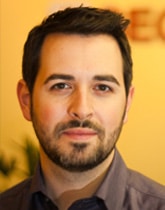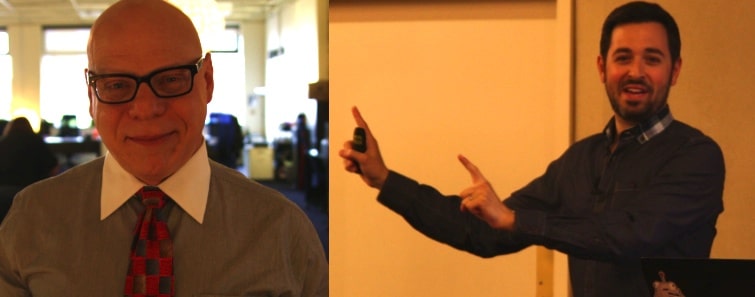The Zenith Social Media Marketing Conference elicited thrills and chills as attendees strolled through the Duluth skyways between the Holiday Inn & Suites and the AIMCLEAR office for an exciting day of all things social! We had a blast attending sessions, taking notes, introducing speakers, and just enjoying the company of all the like-minded marketers who ventured out on a drizzly, chilly day to hang with us in the Northern Midwest
Riling up the crowd first thing yesterday morning, our very own Marty Weintraub shared the floor with some cool folks including Stefan Heeke, Director Digital Communications of Siemens, Lisa Grimm, Senior Social Media Strategist at Imagination, Marc Grabanski, Leader at MJG Internatonal, Brian Kenny, Director of Luther Automotive Group, and Molly Solberg of Duluth Pack. Tackling business social media strategy and tactics head on, this rambunctious panel used real life examples to share their thoughts and expertise with us.
The Zenith agenda packed not only one, but TWO keynote presentations, and our heads are still swimming with all of the super cool concepts each beheld. Keep on reading for the full scoop!
Keynote Q & A: Picking Apart the Experts’ Brains
Attempting to glean every last bit of social media goodness from each of the panelist’s minds, Marty started the session with a few questions for the speakers.

Lisa: To have a solid network of social media people surrounding me for networking and idea-sharing. Having the right community is key. Also, it’s important to be able to show businesses why they need social media and how to go about doing that.
Marty: What’s the structure of your listening apparatus? How do you listen to social media chatter?
Stefan: It’s important to keep track of the chatter with tools and to actively listen to the active community members.
Marty: What’s the part of this industry that you absolutely HAVE to do?
Brian: You need to be on the social channels. Otherwise, you’re missing opportunities. Upset customers can become your best fans and loudest cheerleaders if you respond to them and make it right. The conversations are out there and they are happening every day. You need to be aware of them.
Molly: [Social media] It’s a great way to communicate with customers. It’s easily done for small businesses.
Marc: When it comes to social, you need to provide resources for the open source community. If you have it, share it.
Lisa: The single most important thing you need to know is how to sell. Know your business strategy so you can push it out across the social channels. According to the panel, the next “big thing” in the industry is:
- Listening
- Social as a search engine
When Marty asked if the panelists thought Facebook would start to fall off the radar any time soon, they responded with a unified and resounding “NO!” Facebook is here to stay… Haaaallelujah!
Keynote Round II: Rand Fishkin, Front and Center

“OMG! Facebook is huge. Twitter is big, ahhh, LinkedIn is growing so fast! Pinterest and Tumblr are taking over, OMG I need to check out Foursquare and Quora, there are so many channels!”
Blogs are the biggest social channel out there second only to Facebook, of course. The number of bloggers and blog readers out there amounts to half of the adult population in the United States. Reaaaally? Google+ is a huge advantage for the early adopters.Google wants you on Google+, so just think of the SERP incentives when considering whether you want your brand to be a part of this channel.
Jumping into an example about a family business trying to grow their Facebook community, Rand detailed how the business just couldn’t figure out why their community growth was stagnant. Why didn’t anyone want to “like” their page? Thinking that paying for Facebook ads would expose his page to more people and result in more likes, the business owner jumped head first into ads…to no avail. What’s a business owner to do in a case such as this?
Well… it’s time to start from scratch. Emphasizing the importance of creating a social media strategy, Rand noted this is where to start. You need to have a strategy before anything else. Sharing viral content won’t get you anywhere unless you have a goal in mind:
- What do you want for this content?
- How will you get those likes?
In this particular business owner’s case, he realized Google is where it’s at for his business. Since Google accounts for 92% of their visitors, why should he focus on another channel? Tactics are important to have, but they certainly do not determine success. Your tactics are merely a method for implementing your strategy.
What’s Next? Set Some Goals
When creating your marketing goal, you need to figure out a way to get customers and how to retain them. You need to have a scalable, repeatable model, something that will grow itself. People are having a tough time figuring out social media, which means it’s good for everyone else who gets it.
Google+, Facebook, Twitter and even SEO all have high ROI. If you can make a channel work, you are that much better off than the next guy because, again, not everybody gets it. When the time comes to measure your ROI, paid is always easiest to calculate. You know how much you spent and you know your results. Organic, on the other hand, is a whole other animal. It’s much trickier to measure because a lot of your investment is time and energy and your ROI gradually increases over time.
The vast majority of traffic doesn’t cost anything but sweat… err, time investment. Social media is a scalable, low cost, highly strategic investment that demands creativity, but does not demand dollars. In fact, it rewards people who can be creative without spending money.
If you do something great and share it across the social channels, all the other channels will help you! Great content that gets shared on Twitter will motivate people to share it on LinkedIn or through email, and it will impact search! Social is so powerful because one tweet can literally change the world.
First Thing’s First: Strategy
Start with your strategy before you post viral content. Strategy is the plan of action designed to accomplish your goals. So, how do you determine the best strategy for YOUR brand? Contrary to popular belief, social isn’t about acquiring customers directly. When you browse the web or are contemplating buying something, the process starts with an idea and ends with a recall of a past experience.
The last time you were in the market for a calculator, you most likely remembered something you heard a while back or recalled a previous experience. Rand described the process of acquiring customers directly as a funnel: the top of the funnel consists of people visiting your website for first time. Above even the top of that funnel lies social. Where did they hear your brand name the first time? You want your brand want to earn familiarity, likability, and trust.
If people are familiar with your brand, they are more likely to buy a product or share something socially. If people like your brand, they are more likely to buy a product or share something socially. If people TRUST your brand, they are more likely to buy a product or share something socially.
Social media is an integral part of building your likability, and in turn, trust. Before you jump your brand into any new channel, do the research! Rand suggests using Followerwonk for Twitter. You need to target the right people or else you’re wasting your time. Folloerwonk allows you to do a search for all the people and topics you’re interested in and see who the influencers in each category. How do they rank? Are the people you’re trying to reach actually on this channel? Find out! Do your research first before you just join. Know where to go.
Second Thing’s Second: Implementation
Once you know these things, you can put your faith into those channels. Word of mouth is powerful. When people start social campaigns, their exact target audience may not always be on there, so they may be uninterested in the channel, but this is A MISTAKE.
Is there anyone on that channel who influences or talks to those people you want to target? Think of that! If you’re targeting valve engineers and don’t find them on that channel, but you find related users who impact the valve engineers, target them! You have to start somewhere. A few questions to ask yourself before diving head first into that channel include:
- Can you reach the right people?
- Are you reaching the people you’re targeting or their connections?
- What are you going to do that will interest these people?
- Why will they care about you?
- How can you make yourself stand out above all that noise?
- What are you doing that will earn this interest?
- What incentive do they have to share?
You need the content to get noticed! Lastly, once you reach your target audience, ask yourself whether they will like and trust you more. Are you alienating them somehow? You need to have exceptional user experience when they land on your site. If you can answer all of the above questions, your roadmap and social strategy will become incredibly clear. The biggest takeaway from this session is that social needs to be more strategic.
That about does it for the keynote presentations. We had the opportunity to see lots of other great speakers at Zenith and had a blast sponsoring the event! Thank you to all the speakers who traveled from far and wide to be a part of this conference and to all the attendees for asking some really insightful questions and keeping things entertaining. Until next year!










